If you’re here, you probably already have proxies, and now you want to test them. That’s a great idea because no one can guarantee a proxy server will work as intended. Even if you got your proxies from a reputable provider, testing them to check their performance, reliability, and anonymity can only help.
The question is, how to test proxies? Is it simple or complicated? Does it require any tech experience, or anyone can do it?
The short answer is that testing proxies is nothing complicated if you use the right tools. The first step to learning how to test proxies is to understand why it matters.
Why Test Proxies?
Your reasons for testing proxies may differ from those of another user, but generally, people do it because of the following purposes:
- Ensuring reliability & performance
Testing proxies can help you find out if your proxy addresses are reliable and perform well. Ideally, you want fast proxies no matter how you plan to use them. This is especially true if you need proxies for video editing, gaming, or anything else that requires a high-speed connection.
- Verifying anonymity and geolocation
Using a proxy server that won’t change your geolocation is pretty pointless. If you want a proxy server that’ll make your browsing anonymous, you need to ensure it uses an IP address in a different location. This way, you know the websites and platforms you visit or use can’t see your real IP.
- Compatibility with applications & websites
Not all proxies work with all sites and tools. So, to avoid ending up with a proxy service that doesn’t work with your target site or app, you should test proxies beforehand. It’s better to check proxies than to waste time or money, right?
Proxy Testing Methods
You can test proxies manually or use technology to speed things up. Here’s more about both manual and advanced testing methods.
Manual Testing
Follow the steps to test proxies manually:
- Step 1: Identify your proxy IP address using an IP checker website or your computer settings. For the second option, go to “Control Panel,” click “Internet Options,” tap the “Connections” tab, and choose “LAN settings.” From here, you can see your proxy’s IP and port number.
- Step 2: Verify your proxy location by cross-referencing the proxy’s IP with IP databases. The location information provided by these databases should match the intended location for maximum anonymity when bypassing geo-blocks.
- Step 3: Test proxy speed by downloading files from the target website through the proxy server. Once you determine the proxy speed, compare it to your regular internet connection.
- Step 4: Use an IP checker to confirm your actual IP address is really hidden and replaced with the IP address of the proxy server. It’s an easy way to check the anonymity of your proxy.
- Step 5: Check the proxy type you’re using and whether it supports your target site or app.
- Step 6: Monitor consistency over time to ensure you’re using a proxy with high performance and minimal downtimes.
Repeat the steps as many times as needed until you find the best server for you.
Automated Testing
If you want to test proxies more quickly, you should opt for automated testing. Not only is it faster, but it’s also more accurate and efficient. With the right tools and technology, you do various tests in just a few minutes, from speed tests and IP address checks to proxy type verifications.
Check out some of the options automated testing offers:
- Speed tests
An automated proxy tester lets you check the speed of multiple proxy servers. This way, you can find the ones with the best response times for an optimal online experience and data retrieval.
- IP address checks
With an automated IP checker, you can confirm if proxies really hide your IP address. Instead of cross-referencing the proxy’s IP with IP databases manually, this tool does it all for you, informing you about the proxy’s authenticity and location.
- Proxy type verification
Automated IP checkers can help you quickly find the type of your proxies and use the right one for your tasks without wasting time.
- Bulk proxy testing
Testing multiple proxies manually takes too much time. With automated testing, you can test proxies in bulk and evaluate the performance of the entire IP pool.
- Proxy verifiers
Using a proxy verifier can help you evaluate the proxy’s anonymity level, performance, response time, location, and more. It’s a great way to get a detailed analysis of the proxies rather than running simple tests.
All of these tests can help you check proxies more quickly and efficiently than testing them manually, allowing you to focus on your tasks without delays.
Key Metrics for Proxy Testing
The next time you test proxies, make sure you focus on the following metrics.
Latency: Speed and Responsiveness
This metric shows the performance of your proxies, or how much time they take to respond to your request. Obviously, the less time they take, the quicker you’ll access your desired web source.
Therefore, you need low-latency proxies. Using them will help you enjoy a smooth online experience and data transfer with less lagging and loading time for sites. Low-latency servers are especially useful for tasks that require real-time communication, like live streams or video conferencing.
A proxy checker measures the server latency by sending multiple requests and recording the time it takes to get responses. Make sure you test different proxy servers to check their latency so you can compare the results and find the one with the best response times.
Reliability: Uptime and Connection Stability
Whether your proxies are reliable or not depends on their uptime and connection stability. Knowing that your proxies are reliable will let you focus on your tasks without worrying about interruptions in your connection.
A good proxy tester will give you all the information you need about the proxy’s reliability. These tools monitor the server’s uptime and connection status by sending regular requests and logging any downtime or connectivity issues.
Anonymity: IP Address Security and Concealment
Anonymity is the main reason people use proxies, so you want to ensure the proxy you choose does hide your IP address. This metric is crucial to consider when you test proxies as you don’t want to end up with a server that offers low levels of privacy and security.
IP databases and proxy checkers are great tools for checking proxies’ anonymity levels. A proxy tester checks if the server hides your IP address properly, while an IP database reveals how authentic it is.
This way, you’ll find out if the proxy’s location is the one its provider claims to be and if you’re really anonymous while using the proxy address.
How to Test Proxies: Step-by-Step
If you want to test proxies, just follow the steps below and you’ll soon know everything about your proxy servers.
Step 1: Gathering Proxy Information
Start by collecting crucial information about your proxies. IP databases like IP2Location, DBIP, and AbuseIPDB can show you more details about your IP address, including:
- IP location to check if the proxy is operating from the expected region.
- ISP or internet service provider to confirm the proxy’s authenticity.
- ASN to understand the proxy’s network characteristics.
- Proxy status to see if the IP is recognized as a proxy, in which case your target site will most likely recognize it, too.
We tested a random free proxy server on the IP2location proxy checker, and here are the results.

As you can see, you get geolocation and proxy data showing the IP address comes from Rancho Santa Margarita, California, US. You get plenty of other useful information, including the ZIP code, proxy type, anonymity level, and security threat.
Other sites like AbuseIPDB check the IP's history so you can see if it was ever reported for malicious activity in the past.
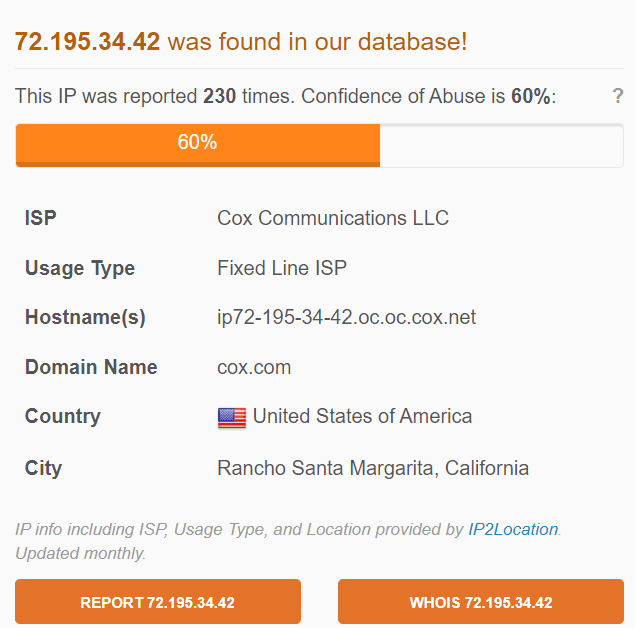
As you can see, this proxy checker uses the IP2Location database for information such as ISP, usage type, and location. According to the results, the IP address we tested has been reported 230 times, so you should avoid it.
Step 2: Using Online Proxy Testers
Use an online proxy tester like HideMyName to see if your proxies are working. You can copy an entire list of proxies from a random provider’s site and check them all at once.
Here’s what we got after testing a list of seven proxies:
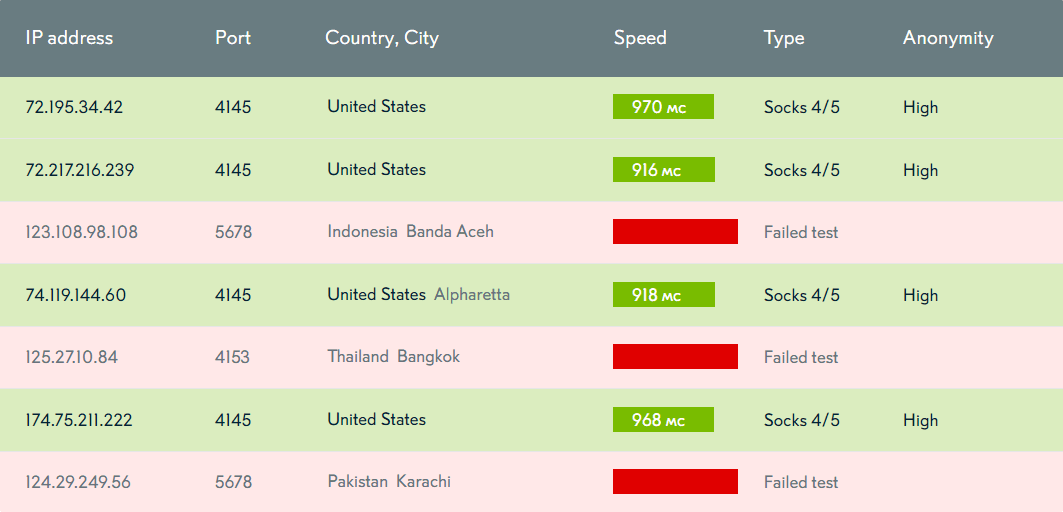
These tools can give you a detailed report about your servers, including their IP location, response speed, proxy type, anonymity level, etc.
Step 3: Using Proxy Testing Software
A good proxy checker like FOGLDN Proxy Tester allows you to test premium proxy types without worrying about leaking your credentials. You can test entire proxy lists against specific websites, export working proxies, check proxy speed, and more.
We used the FOGLDN Proxy Tester to find out details about a few premium proxy servers. Here are the results:
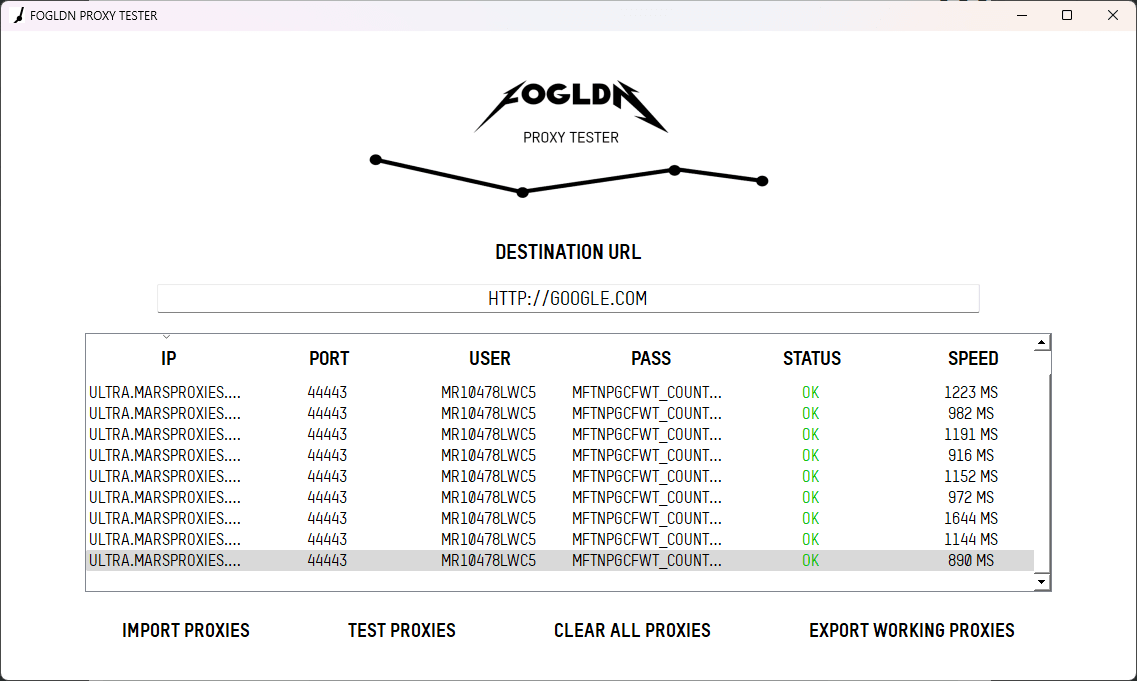
The tool allows you to test any proxy type, including sticky and rotating IPs, after downloading and installing it on your device at no charge.
Step 4: Checking for IP Leaks and Anonymity
Did you know that you can get a proxy IP address but still use the DNS servers of your "real" ISP? In that case, your real location will be revealed, as well as the fact that you’re using a proxy - this issue is also known as a DNS leak.
Sites like DNSLeakTest can help you check proxies for IP leaks and anonymity so you can choose ones that won’t expose you. Additionally, BrowserScan and similar sites don't just test the proxy and DNS leaks but your entire browser fingerprint for any inconsistency.
This is just the tip of the iceberg when checking a proxy with BrowserScan:

Step 5: Testing Proxy Speed and Performance
After using a proxy checker to discover response speeds, it’s time to find out the proxy’s download and upload speed. For this, use a site like Speedtest. Run a test with your "regular" internet connection to check the speed you get from your ISP.
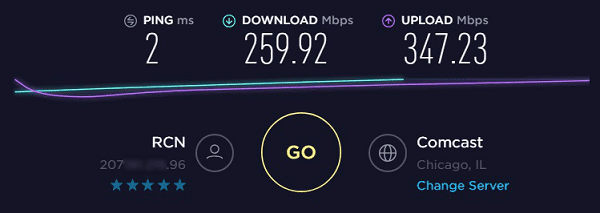
Then, run another test through your proxy, and you’ll see the proxy's speed. This way, you can compare both speeds and select the fastest proxies.

Best Tools for Testing Proxies
Even though we already mentioned a few proxy checkers, we want to make things as clear for you as possible. So, if you want to test proxies, here are some of the best tools to consider.
Hidemy.Name
This proxy tester is packed with plenty of features, letting you check compatibility, verify anonymity, and get details about the proxy performance.
It’s free and easy to use, so you just enter the proxy list and hit the “Start new check” button.

The results will tell you the proxy type, speed, location, and anonymity level. You can export the test results in a .txt or .csv file.
TestMyProxies
Using this proxy checker is a no-brainer. You add your proxies in the designated field and hit the “Test proxies” button to separate good from bad options. TestMyProxies lets you test premium proxy lists with up to 500 IPs per request and check out the anonymity, location, type, and speed of each proxy.

Angry IP Scanner
This free, open-source proxy checker works on various platforms, including Mac, Windows, and Linux. It lets you scan proxy servers in any IP range to test their speeds. Angry IP Scanner can also test the uptime of the proxies, scan the ports, and show the MAC addresses of the proxy servers.
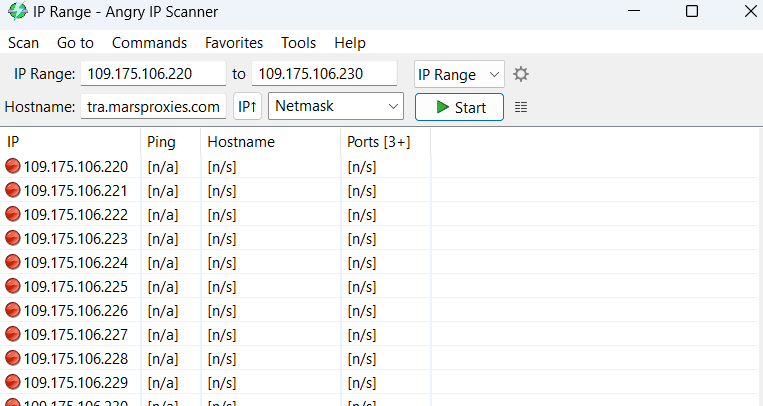
You can export the results in multiple formats, for maximum convenience.
FOGLDN Proxy Tester
This popular tool works on both Windows and Mac devices. It’s free, and it shows your proxies’ reliability and performance. Once you download and install it on your PC, you can add entire proxy lists and test them at once.
The results will show you their status and speed so you can select the fastest ones available. Here’s what we got when testing a premium proxy list on FOGLDN:
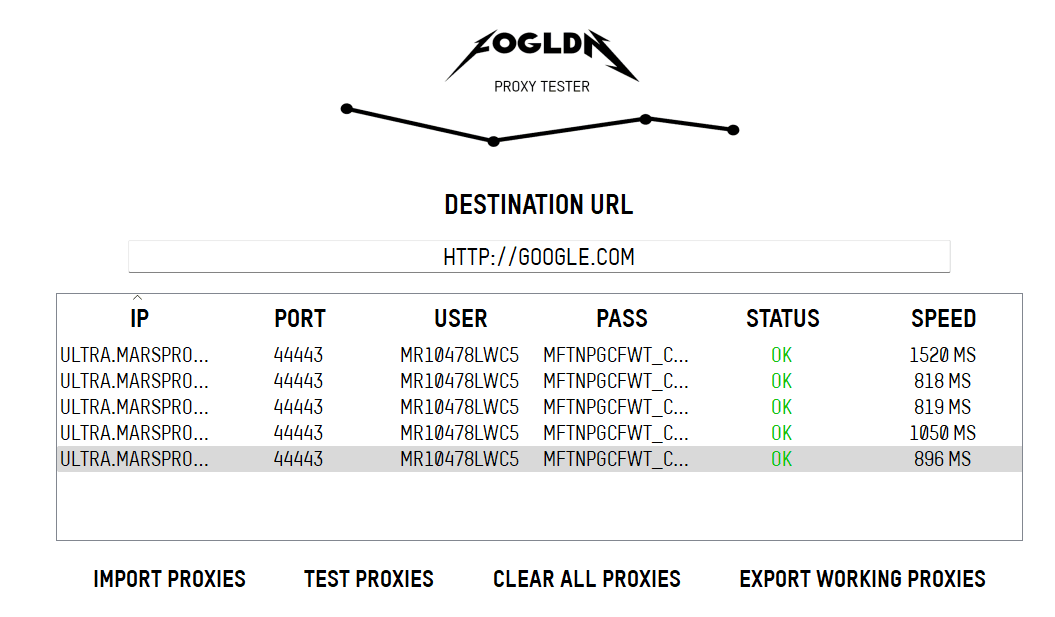
While all the proxies we tested have OK status, some of them are significantly faster than others.
Proxy-Checker
This simple tool checks if your proxies really hide your IP address. Proxy-Checker is free and has a user-friendly interface, allowing you to check up to 10 IPs at once.
We tested five public proxies:
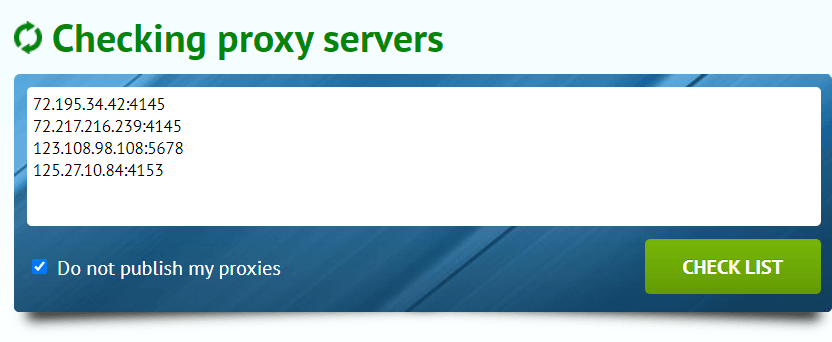
The results showed that only one of them is working:
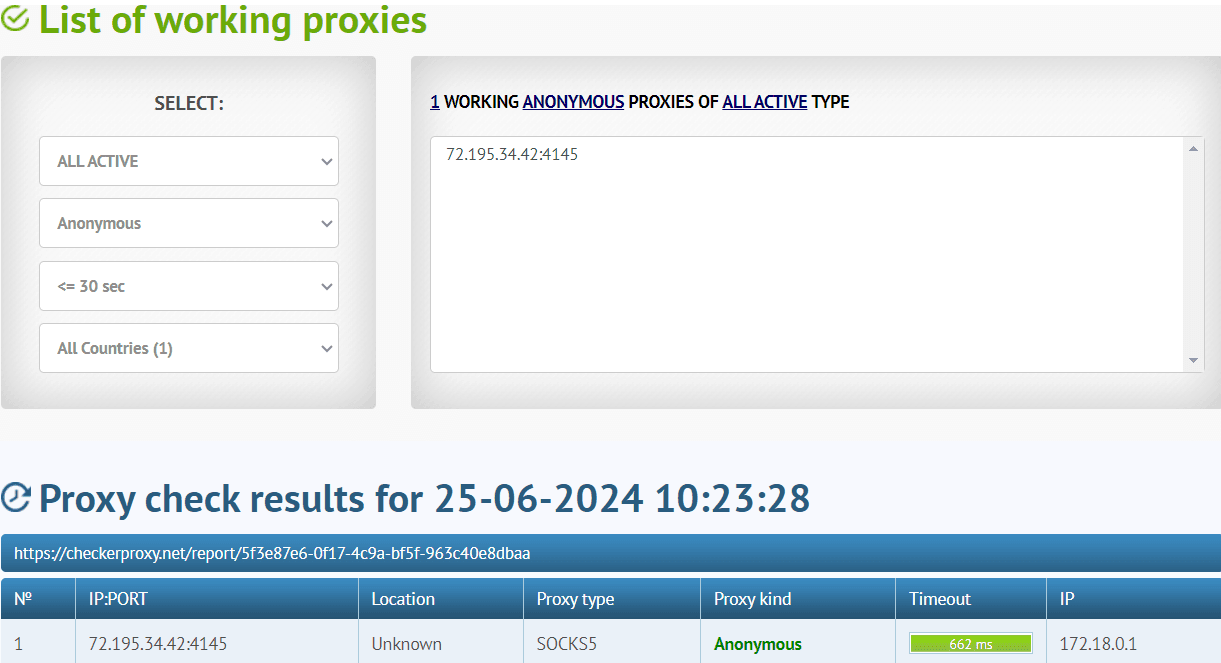
Proxy Testing Best Practices
To make this process easier and more efficient for you, we share a few tips that will help you test proxies without wasting time.
Choose Appropriate Proxies
Think about what proxy type you need before testing. For example, residential proxies are more authentic, coming from regular internet users. So, if you need proxies that won’t reveal you’re using one, test residential proxies.
On the other hand, datacenter proxies are faster, so test them if you need a high-speed connection. You should also consider IPs with relevant locations, based on your internet needs.
Establish a Routine for Testing
Establish a routine testing schedule and use automated tools to streamline the process. Regular testing will help you monitor your proxy servers’ performance and improve settings accordingly.
Ensure Detailed Reporting and Documentation
Testing your proxies once or twice is not enough. If you want to ensure you’re always using high-performance proxies in the right location that will maintain your privacy, you need to keep detailed records of their metrics, such as reliability, latency, and anonymity levels.
This will allow you to compare multiple proxies and troubleshoot any issues quickly so you can find the solution ASAP.
Visualize Performance Trends
Using graphs and charts in your documents will help you keep things nice and organized. This way, you can identify existing trends and patterns and share them with your co-workers.
By detecting potential problems, you and your team will be able to solve them quickly and maintain uninterrupted operations.
To Sum Up
If you haven’t tested proxies by now, you should start doing it to ensure they keep your IP address hidden and perform well. With our easy-to-follow guide, you can start testing various proxies until you find the ideal servers for you.
FAQ
How often should I test my proxies?
In general, it depends on how you use your proxies. If you use them to access or transfer sensitive data, testing them regularly can help ensure your operations run smoothly. For casual internet browsing, test them less frequently.
What should I do if a proxy fails the test?
Check if the proxy details are entered correctly. Ensure your proxy settings match the requirements of your proxy provider. If the proxy still fails the test, contact your provider. If you’re using a free or public proxy, switch to another one.
How can I ensure my proxy is compatible with specific applications?
Check the app’s documents to understand its proxy requirements, such as supported protocols and authentication methods. Look for a proxy with the required settings and see if it works with the app. Adjust the settings and contact the provider for assistance as needed.



